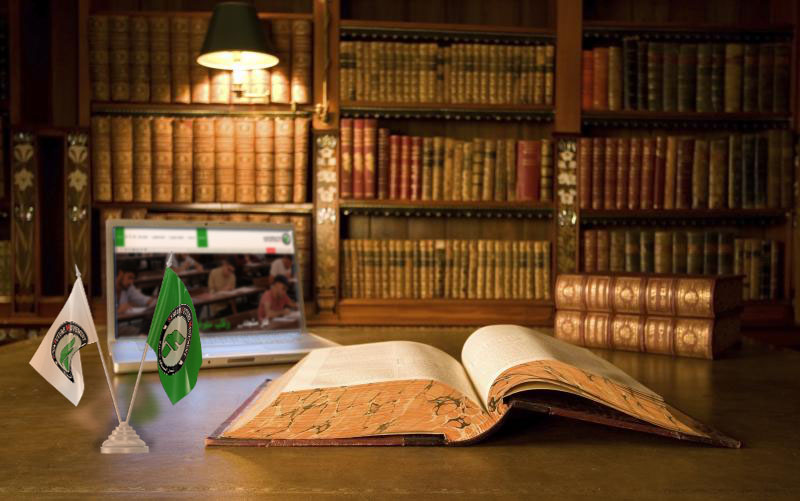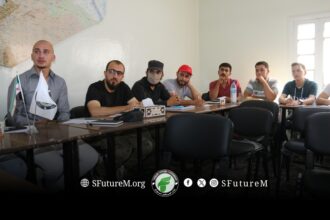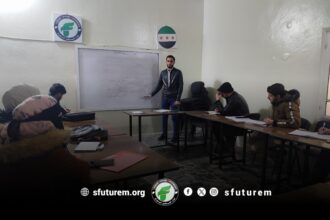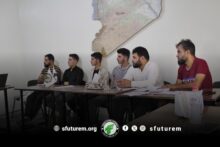Scenario of Unifying the “Interim” and “Salvation” Governments

Introduction:
The efforts of Hay’at Tahrir al-Sham (HTS) to unify the factional work under what was called the “Unified Force” failed when the Mutasim Brigade withdrew from it a few days ago. However, this failure carries within it the seed of acceptance for the idea of merging between HTS on one hand, and the official opposition “National Army” on the other hand. Despite the complexity of the situation, this study reads the scenario of this merger with a cool mindset, starting from the principles of political thought about the concept of the social contract and its necessity.
Undoubtedly, in the Syrian Future Stream, we carry a national idea that unites all of Syria. This unifying national idea is considered an ultimate goal, and we see the necessity of considering it as the axis of work for all patriotic Syrians. However, in this study, we start from a calm and realistic reading that looks at the current situation, deconstructs its image to restructure it into a single structure that might help decision-makers to broaden their vision. Therefore, it can be said that we generally do not adopt the idea of merging with terrorist groups, nor with organizations that have a negative history with the revolution forces, but the cool reading leads to dealing with the elements of the study without wishful intervention or emotional influence.
The study starts from a single hypothesis, which is the acceptance of the conflicting forces in Northwestern Syria of the idea of merging into one inclusive political entity, and any future contradiction of this hypothesis will invalidate all its foundations.
Then, the first thing we build on this hypothesis is considering any merger and unity between the two entities that does not start from a state-level merger through an official governmental relationship; it is a merger that will not go beyond the military mentality, which generally does not believe in anything other than overcoming and the sole bet on the efficacy of weapons. However, governmental merger, even if it needs military support, is the only gateway that should end with responsibility and decision-making, through a regulating political vision that makes the military subordinate to a governmental authority, not the other way around!
Therefore, we will define, according to this narrative, three entries that aid in good description and research recommendation, which are: (Commonalities), (Difficulties), and (Gains).
The First Entry:
(Commonalities between the two governments):
The Salvation Government and the Interim Government share several internal and external issues that make the possibility of their merger plausible.
1- From the internal perspective:
A. Unity of the fighting fronts, where both governments share a military connection in a single front against their opponents. In Hama countryside, the military fronts witness wide participation by the National Liberation Front with approximately ten factions led by Ahrar al-Sham, while HTS participates with a third of its military capabilities in Hama countryside. In the eastern countryside of Idlib, forces of “Faylaq al-Sham” spread, with a clear dominance of HTS, and in the southern countryside of Aleppo and the northern western suburbs, Faylaq al-Sham’s control appears with about two-thirds of dominance along with a third for HTS, and in the northern Latakia countryside, HTS shares dominance with the National Liberation Front.
B. The presence of legal figures in both governments who advocate for and desire merger over the state of dispersion, considering that the role of legal scholars in Northwestern Syria is significant in terms of impact. This legal presence was manifested by the visit of the Salafi Sheikh “Abdul Razzaq al-Mahdi” to the areas controlled by Olive Branch in 2020, after the legal scholar “Abu al-Fath al-Farghali” called for reconciliation between HTS and the National Army, and positions of Sheikh Ayman Haroush, Ali Shohood, and others, who advocate for rapprochement between the National Army and HTS, which prompted a statement from Sheikh Shohood, justifying his position that changed after significant hostility towards HTS.
C. Desire for a political future, where the first generation of armed work aimed to establish a base for subsequent generations to build upon, considering themselves at the beginning of armed work as the bridge that later leaders would walk on. Today, the political awareness carved by past experiences has made leaders, whether political or military, think about future presence rather than gratuitous sacrifice, as observed by us, the observers of the revolution’s beginnings, and can be exemplified by an important statement to Arabi21 by Khaled Abdel Walid Abu Anas, one of Ahrar al-Sham’s leaders in 2019, stating that they have been working on a social and political future for the past two and a half years -from the date of the statement-.
D. The existence of a popular support for the idea of unifying the region and its necessity, considering that the region is inhabited by Syrians who have lived the same suffering and share the same identity and culture.
2- From the external perspective:
A. Shared enmity against the Syrian regime and its allies.
B. Viewing the Syrian Democratic Forces (SDF) as a threat to the region.
C. The presence and relative influence of Turkish forces in both governments, where Turkey directly oversees the local councils managing the areas between Jarablus, al-Bab, and Afrin under the Syrian Interim Government, and the presence of Turkish military bases in HTS areas, the latest being a military point in the eastern district of Afes town in eastern Idlib, in addition to both governments needing a regional depth represented by Turkey.
The Second Entry:
(Difficulties of Integration):
All the aforementioned commonalities collide with a solid wall of difficulties standing in the way of any real and effective integration. Most of these difficulties are not apparent in the general picture but lie deep within the revolutionary or jihadist scene, as the military and legal scholars prefer to describe it in the north. Since the devil lies in the details, we will delve deep into this scene and search for those difficulties, acknowledging that we will overlook the difficulties we do not see as having a significant impact on the integration issue, such as cases of mutual vendettas, the presence of figures who see integration as a significant risk to their interests, or a risk to the region for various reasons, and more!
A. One of these difficulties lies in the presence of Abu Muhammad al-Julani himself, a figure that has become a burden on HTS, evident in his failure to manage the file of agents for the coalition, and also seen in the request by the public relations officer of HTS, Ali Saber, for al-Julani to step down and resign. Al-Julani’s personality has also become a burden on the acceptance of some factions to cooperate with him as a leader, due to the loss of mutual trust with him because of his pragmatic stance, and the difficulty of al-Julani’s presence is also in the impossibility of him leaving public work and leading HTS, in addition to the absence of a unifying figure with charisma and a history similar to al-Julani’s, along with al-Julani’s non-acceptance of anything other than the concept of allegiance!! Since his inception, he has been trying to obtain allegiances from military leaders, and does not see cooperative or institutional collaboration as a unifying contract, to the extent of considering himself, the Sunni version of “Hassan Nasrallah”.
B. The listing of “Hay’at Tahrir al-Sham” on the US Treasury’s terrorism list, which would make any integration with it a card in Russia’s hand, making the “Euphrates Shield”, “Olive Branch”, and “Peace Spring” areas similar to the Idlib region in terms of being targeted by Syrian and Russian artillery and air strikes. Therefore, this designation on HTS makes it difficult for other factions to accept merging with it, especially after HTS’s failure to remove its name from the US terrorism list, or even its failure to have it removed from Turkey’s terrorism lists, which has been in place since 2018!.
C. Factional military conflict, manifested when “Hay’at Tahrir al-Sham” sent military reinforcements from Idlib through the Ghazawiya crossing (separating its control areas in Idlib from the “Syrian National Army” control areas in Aleppo), announcing that it entered the region to end infighting and restore security, before turning into a party that fought the “Third Legion” and made it withdraw from the city of Afrin, and also by the recent problem with the siege of the faction (Ahrar Olwan) on the village of Abla east of Aleppo, and the defection of the leader (Abu Ahmad Zakoor) from HTS ranks, and what it led to of clashes that would have spread were it not for direct Turkish intervention, along with the appearance of tribal calls that reject HTS on one hand, and only look with a tribal eye, not interested in governmental work at all, let alone the idea of integration from another side, especially since some military factions in the National Army are tribally linked and not institutionally among themselves, which makes the social reality fragile in the region.
D. The spread of Salafi jihadist ideology, especially in Idlib, which rejects any political system not based on the idea of a dominance-based caliphate, and does not accept the democratic system in any form, making it difficult to accept the Salvation Government’s participation with the Interim Government! Which sees democratic practice, even theoretically, and considers it the system in place in its political regime.
E. Security ties with major countries, especially the United States, make the current form and regime of Hay’at Tahrir al-Sham (HTS) a pace-setter for Salafi jihadism not only in Syria but globally, especially after the death of al-Zawahiri two years ago. This positions al-Qaeda along with HTS as a new version being crafted in a way that does not threaten American interests. Additionally, Turkey’s rejection of merging the Salvation Government with the Interim Government, fearing the loss of areas under its influence, and Turkish considerations of repeating the Afrin scenario in Idlib, highlight the complex relationship with HTS since the famous statement by Turkish President’s advisor Yasin Aktay in 2019, about Turkey’s patience running thin and having plans for more than one scenario, indicating that it will not wait indefinitely. This relationship appears to remain tense to this day.
The Third Entry:
(Gains of Integration):
Are there actual gains from the integration between the two governments? This question should fundamentally follow the study of difficulties to assess feasibility.
The impact of political geography on creating gains could serve as a basis for consolidating them in a single framework, but that’s not enough! It requires adding the “eagle eye” perspective that views from a height to fully outline the scenario for decision-makers, along with considering future viability, which uses outcomes as a targeting basis for gains, filtering out the illusory from the substantial. Here, we see the considerable gains of integration as follows:
A. Moving a first step towards implementing the West Germany model, which the Syrian Future Stream considers one of the paths to the general Syrian solution. Crafting a national Syrian social contract for all areas outside regime control is a significant challenge for Syrian actors, and a realistic bet on Syrians’ ability to build a modern contractual state that respects diversity away from the concept of tyranny and Assad’s authority.
B. The region lives in a reality of constant tension in all directions, in addition to military forces being occupied with internal fronts that may come at the expense of the main front. Therefore, easing tensions and cooling off internal fronts, whatever they may be, is undoubtedly a national gain. Furthermore, moving from violent political conflict to peaceful dispute is a reason to strengthen internal unity, which would be a benefit provided by the integration between the two governments.
C. Any integration through governance will be the first building block in escaping the factional situation and starting the phase of institutionalization and governance, which in itself is a significant gain.
D. As clearly seen, there is a significant and deep conflict between the two governments – representing different carriers factionally, popularly, intellectually, and otherwise. For Syrians to overcome these disagreements, digest them, and find coexistence solutions means they will later be able to unravel other disputes, granting them the ability to create solutions and deal with others, leading properly towards establishing a “state-like” Syria that is original and where disagreements do not hinder its establishment.
E. Economic growth in the region due to capitalizing on investment funds that will find a broader space for their investments and collaborative projects, in addition to opening all crossings and barriers between the two governments, and placing external crossings with the regime, SDF, and Turkey under one administration to enhance development and the budget of the new government.
Conclusion:
The overall Syrian reality today can be described as a drowning swamp for anyone who enters it for two main reasons:
First: The international conflict and the presence of foreign armies fighting each other on Syrian soil in one way or another.
Second: The internal fragmentation and division of Syria into four unstable, conflicting regions!
The draining of this swamp begins with any scenario that reduces the impact of the aforementioned reasons. Implementing the “West Germany” project, which the Syrian Future Stream considers as “Syria’s grandmother” in terms of contextual similarities with Syria, might be a first step towards this project; unifying the two governments is considered a positive act if it takes into account the magnitude of difficulties and their role.
In addition, the need for “political Sunnism” -if the term is appropriate- to be able to unify its bloc against the minority axis led by Assad, and the Kurdish democratic axis led by SDF, where this Sunni political success is also considered one of the cards in combating extreme Sunni calls.
- Undoubtedly, the Syrian people have diverse orientations, but those who control the land are primarily of interest to the political researcher, and thus, it can be said with some sadness that this is what the Syrian people were able to produce in terms of entities that represent them, and therefore, it would be realistic politically to deal with and dissect them as Syrian.
For this reason, we in the Syrian Future Movement (SFM) recommend the following:
1- Intensify the studies and research focused on the interior of Syria, and the relationship between the different forces. This includes broadening the perspective for decision-makers regarding the political participation of these forces, realistically studying their potential, addressing their issues in practical terms, and providing recommendations relevant to achieving strategic national goals, ultimately leading to the building of a modern, national Syrian state, which appears to be a long-term goal, unfortunately.
2- Exercise caution in any form of unity; ensuring it does not become a factor of weakness instead of strength. This can be achieved through integration based on sound contractual foundations that offer guarantees for all significant apprehensions among the factions, coupled with a deep examination of external factors and their impacts in both the short and long term.
3- View the unity between the Salvation Government and the Interim Government as a Syrian national challenge that lays the groundwork for the future.
4- Assist Hay’at Tahrir al-Sham in getting its name removed from international terrorism and sanctions lists, in exchange for practical steps towards unity or the building of national partnerships.
5- Preserve the Turkish umbrella, considering it the current guarantor for the region, and seek Turkey’s assistance in achieving unity in a manner that does not harm the region and maintains its security.
6- Advocate for Abu Mohammad al-Julani to step down from public work, for the public good.
Jomaa Mohamad Laheep
Scientific Office
Research and Studies Department
Studies
Syrian Future Movement (SFM)
References:
- Al-Mutasim Brigade ends its membership in the “Unified Force” in Aleppo countryside (syria.tv)
- Sheikh Ali Al-Shahood on X: “A clarifying statement about my change of stance towards Hay’at Tahrir al-Sham https://t.co/9LVOQcAL6x” (twitter.com)
- The military scene becomes more complicated.. 6 questions and their answers regarding the military developments in northern Syria | News | Al Jazeera Net (aljazeera.net)
- Map of military spread in Idlib fronts and its surroundings (almodon.com)
- After “Al-Muhaysini”.. What is “Abdul Razzaq Al-Mahdi’s” message to the “National Army”? | Baladi News Network (baladi-news.com)
- Turkey monitors the regime.. A new military point in Idlib (alarabiya.net)
- Ali Saber – When the spark of the Dignity Revolution ignited in Daraa, I was following the channels… (facebook.com)
- “Al-Julani’s Journey”.. From the womb of “ISIS” to the clone of “Hezbollah” | Al Jazeera Net (aljazeera.net)
- America imposes sanctions on financiers for Hay’at Tahrir al-Sham in Syria – CNN Arabic
- “Al-Qaeda” and “Hay’at Tahrir al-Sham” and the future of the jihadist movement | The Washington Institute
- Why is it extremely difficult to be removed from the terrorism list? | The Washington Institute
- Turkey classifies Hay’at Tahrir al-Sham in Syria as a terrorist organization | Reuters (reuters.com)
- From global jihad to local order: “Hay’at Tahrir al-Sham” builds different forms of legitimacy | The Washington Institute
- Does Turkey support the expansion of “Hay’at Tahrir al-Sham” in northern Syria? (aawsat.com)
- After “losing patience”.. Will Turkey begin action against “Tahrir al-Sham”? … (arabi21.com)






